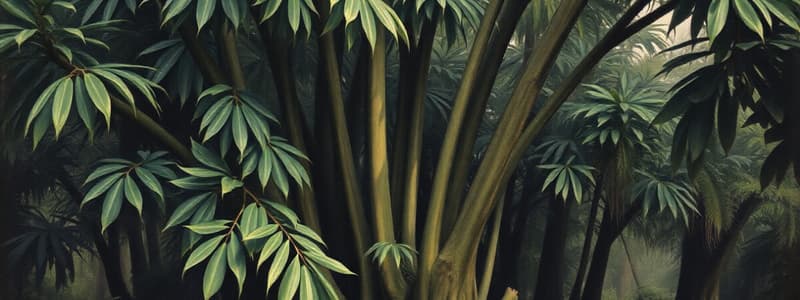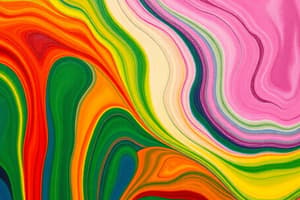Podcast
Questions and Answers
What is a primary disadvantage of synthetic rubber compared to natural rubber?
What is a primary disadvantage of synthetic rubber compared to natural rubber?
- It is generally considered inferior. (correct)
- It is biodegradable.
- It is more flexible.
- It is derived from renewable resources.
Which countries contribute the most to global natural rubber production?
Which countries contribute the most to global natural rubber production?
- China, Vietnam, and Mexico
- Brazil, India, and Nigeria
- Colombia, Peru, and Egypt
- Indonesia, Malaysia, and Thailand (correct)
What innovative method did the Mayans use to enhance the durability of rubber?
What innovative method did the Mayans use to enhance the durability of rubber?
- Using morning glory sap (correct)
- Adding pine resin
- Mixing in animal fat
- Incorporating clay
What is the main structural component of plant latex?
What is the main structural component of plant latex?
How much of the annual rubber production is sourced from natural rubber?
How much of the annual rubber production is sourced from natural rubber?
How does the Para rubber tree primarily respond to injury?
How does the Para rubber tree primarily respond to injury?
What process stabilizes rubber against temperature changes by cross-linking isoprene polymers?
What process stabilizes rubber against temperature changes by cross-linking isoprene polymers?
What significant discovery did Charles Goodyear make in 1839 that changed rubber properties?
What significant discovery did Charles Goodyear make in 1839 that changed rubber properties?
Which of the following is NOT a minor component found in plant latex?
Which of the following is NOT a minor component found in plant latex?
What problem did Charles Macintosh's waterproof cloth face?
What problem did Charles Macintosh's waterproof cloth face?
Where does the Para rubber tree predominantly produce latex?
Where does the Para rubber tree predominantly produce latex?
What method did indigenous rubber tappers in Brazil use to coagulate raw latex?
What method did indigenous rubber tappers in Brazil use to coagulate raw latex?
What effect does vulcanization have on crude rubber?
What effect does vulcanization have on crude rubber?
During which period did crude rubber begin to be exported to Europe in large quantities?
During which period did crude rubber begin to be exported to Europe in large quantities?
Which fungus primarily affects the Para rubber tree in its native habitat?
Which fungus primarily affects the Para rubber tree in its native habitat?
What is the formula for isoprene, the repeating unit in polyisoprene?
What is the formula for isoprene, the repeating unit in polyisoprene?
What is the primary reason for using Guayule latex in medical products?
What is the primary reason for using Guayule latex in medical products?
In what significant historical context was guayule first utilized for latex production?
In what significant historical context was guayule first utilized for latex production?
What unique characteristic does chicle possess that made it popular among Indigenous Americans?
What unique characteristic does chicle possess that made it popular among Indigenous Americans?
What was one of the primary uses of gutta-percha in the 1800s?
What was one of the primary uses of gutta-percha in the 1800s?
Why did many guayule plantations established in the late 1940s ultimately get abandoned?
Why did many guayule plantations established in the late 1940s ultimately get abandoned?
Which type of rubber is known for causing severe allergic reactions due to trace proteins?
Which type of rubber is known for causing severe allergic reactions due to trace proteins?
What is a significant industrial benefit of guayule latex compared to synthetic rubber?
What is a significant industrial benefit of guayule latex compared to synthetic rubber?
What major incident occurred in the Belgian Congo related to rubber production around 1911?
What major incident occurred in the Belgian Congo related to rubber production around 1911?
Which factor contributed to the failure of Henry Ford's 'Fordlandia' project?
Which factor contributed to the failure of Henry Ford's 'Fordlandia' project?
Who patented the first practical application of pneumatic tires?
Who patented the first practical application of pneumatic tires?
What was a key factor in Henry Wickham's smuggling of rubber tree seeds?
What was a key factor in Henry Wickham's smuggling of rubber tree seeds?
What was the significance of Akron, Ohio, in the rubber industry during the early 1900s?
What was the significance of Akron, Ohio, in the rubber industry during the early 1900s?
Which of the following best describes the labor conditions in the Belgian Congo during the rubber harvesting period?
Which of the following best describes the labor conditions in the Belgian Congo during the rubber harvesting period?
What technological advancement increased the demand for rubber in the late 19th century?
What technological advancement increased the demand for rubber in the late 19th century?
Which event in the 1870s significantly impacted the global rubber supply?
Which event in the 1870s significantly impacted the global rubber supply?
What is the primary purpose of latex in plants?
What is the primary purpose of latex in plants?
The Para rubber tree primarily produces latex from its leaves.
The Para rubber tree primarily produces latex from its leaves.
What process is used to stabilize rubber against temperature changes?
What process is used to stabilize rubber against temperature changes?
Plant latex is composed predominantly of ______ in water.
Plant latex is composed predominantly of ______ in water.
Match the following properties or components associated with rubber:
Match the following properties or components associated with rubber:
Which of the following is a significant component added during vulcanization?
Which of the following is a significant component added during vulcanization?
The formula for isoprene, the repeating unit in polyisoprene, is ______.
The formula for isoprene, the repeating unit in polyisoprene, is ______.
Natural rubber becomes brittle when heated.
Natural rubber becomes brittle when heated.
What is the primary use of natural rubber in modern manufacturing?
What is the primary use of natural rubber in modern manufacturing?
Synthetic rubber is more renewable than natural rubber.
Synthetic rubber is more renewable than natural rubber.
The process used to improve the durability of rubber discovered by Charles Goodyear is called __________.
The process used to improve the durability of rubber discovered by Charles Goodyear is called __________.
Match the following historical figures with their contributions to rubber:
Match the following historical figures with their contributions to rubber:
Which of the following statements best describes a disadvantage of crude rubber?
Which of the following statements best describes a disadvantage of crude rubber?
The Mayans invented methods to make rubber more durable by adding morning glory sap.
The Mayans invented methods to make rubber more durable by adding morning glory sap.
What did indigenous rubber tappers create by coagulating raw latex?
What did indigenous rubber tappers create by coagulating raw latex?
Gutta-percha becomes brittle when cooled.
Gutta-percha becomes brittle when cooled.
What unique property makes gutta-percha a good choice for electrical insulation?
What unique property makes gutta-percha a good choice for electrical insulation?
Match the following latex sources with their unique properties:
Match the following latex sources with their unique properties:
Which of the following was a historical use of chicle?
Which of the following was a historical use of chicle?
Guayule was first utilized for latex production during World War I.
Guayule was first utilized for latex production during World War I.
What happened to the guayule plantations established in the late 1940s?
What happened to the guayule plantations established in the late 1940s?
Who patented the process of vulcanization in 1843?
Who patented the process of vulcanization in 1843?
Henry Ford successfully established a rubber plantation called 'Fordlandia' in Brazil.
Henry Ford successfully established a rubber plantation called 'Fordlandia' in Brazil.
What was the main reason for the surge in rubber demand in the late 19th century?
What was the main reason for the surge in rubber demand in the late 19th century?
Henry Wickham smuggled 70,000 rubber tree seeds from _____ to break the Brazilian rubber monopoly.
Henry Wickham smuggled 70,000 rubber tree seeds from _____ to break the Brazilian rubber monopoly.
Match the following individuals with their contributions to the rubber industry:
Match the following individuals with their contributions to the rubber industry:
What type of labor was employed by King Leopold II of Belgium to harvest rubber?
What type of labor was employed by King Leopold II of Belgium to harvest rubber?
The global significance of Akron, Ohio, in the rubber industry declined due to the introduction of radial tires.
The global significance of Akron, Ohio, in the rubber industry declined due to the introduction of radial tires.
By what year had one-third of the global rubber supply been obtained through wild harvesting in the Belgian Congo?
By what year had one-third of the global rubber supply been obtained through wild harvesting in the Belgian Congo?
Flashcards
Natural Rubber
Natural Rubber
A natural polymer found in the latex of rubber trees, known for its elasticity and resilience.
Vulcanization
Vulcanization
The process of adding sulfur to rubber, making it more durable, heat-resistant, and less prone to degradation.
Synthetic Rubber
Synthetic Rubber
A type of rubber synthesized from petroleum-based monomers, often used as a cheaper, but less durable alternative to natural rubber.
Hysteresis
Hysteresis
Signup and view all the flashcards
Rubber Tapping
Rubber Tapping
Signup and view all the flashcards
Rubber Latex
Rubber Latex
Signup and view all the flashcards
Rubber's Historical Use in Brazil
Rubber's Historical Use in Brazil
Signup and view all the flashcards
Rubber's Historical Use by Mayans
Rubber's Historical Use by Mayans
Signup and view all the flashcards
Plant Latex
Plant Latex
Signup and view all the flashcards
Polyterpenes
Polyterpenes
Signup and view all the flashcards
Lactifer Cells
Lactifer Cells
Signup and view all the flashcards
Elastomer
Elastomer
Signup and view all the flashcards
Thermoplastic
Thermoplastic
Signup and view all the flashcards
Thermoset
Thermoset
Signup and view all the flashcards
Carbon Black
Carbon Black
Signup and view all the flashcards
Henry Wickham
Henry Wickham
Signup and view all the flashcards
Kew Gardens
Kew Gardens
Signup and view all the flashcards
Belgian Congo Rubber Exploitation
Belgian Congo Rubber Exploitation
Signup and view all the flashcards
Fordlandia
Fordlandia
Signup and view all the flashcards
Pneumatic tire
Pneumatic tire
Signup and view all the flashcards
Akron, Ohio
Akron, Ohio
Signup and view all the flashcards
Bias-ply tire
Bias-ply tire
Signup and view all the flashcards
Rubber Crump
Rubber Crump
Signup and view all the flashcards
Guayule
Guayule
Signup and view all the flashcards
Guayule Latex
Guayule Latex
Signup and view all the flashcards
Gutta-Percha
Gutta-Percha
Signup and view all the flashcards
Gutta-Percha Latex
Gutta-Percha Latex
Signup and view all the flashcards
Chicle
Chicle
Signup and view all the flashcards
Chicle Latex
Chicle Latex
Signup and view all the flashcards
What is plant latex?
What is plant latex?
Signup and view all the flashcards
What are polyterpenes?
What are polyterpenes?
Signup and view all the flashcards
What are lactifer cells?
What are lactifer cells?
Signup and view all the flashcards
What is an elastomer?
What is an elastomer?
Signup and view all the flashcards
What is thermosetting?
What is thermosetting?
Signup and view all the flashcards
What is vulcanization?
What is vulcanization?
Signup and view all the flashcards
What is carbon black?
What is carbon black?
Signup and view all the flashcards
What is rubber tapping?
What is rubber tapping?
Signup and view all the flashcards
Who is Henry Wickham?
Who is Henry Wickham?
Signup and view all the flashcards
Who is Henry Ford in relation to rubber?
Who is Henry Ford in relation to rubber?
Signup and view all the flashcards
What is the impact of the pneumatic tire?
What is the impact of the pneumatic tire?
Signup and view all the flashcards
What was the significance of radial tires?
What was the significance of radial tires?
Signup and view all the flashcards
What was Akron, Ohio famous for?
What was Akron, Ohio famous for?
Signup and view all the flashcards
Why did rubber production shift to Southeast Asia?
Why did rubber production shift to Southeast Asia?
Signup and view all the flashcards
How was rubber harvested in the Belgian Congo?
How was rubber harvested in the Belgian Congo?
Signup and view all the flashcards
Chicle Tree
Chicle Tree
Signup and view all the flashcards
Gutta-Percha Tree
Gutta-Percha Tree
Signup and view all the flashcards
Study Notes
Latex (Rubber) Products
- Latex is a stable emulsion of polyterpenes (like polyisoprene) in water, with minor components such as proteins, alkaloids, resins, and gums.
- Polyterpenes are composed of carbon atoms attached to hydrogen atoms, featuring both single and double bonds.
- These polymers are made of repeating isoprene units (C5H8) hydrocarbons.
- Specialized cells called lactifers produce latex, located in the inner bark, taproot, or leaves, depending on the plant species.
- Latex primarily serves to protect plants from injury, pests, and pathogens. It also seals wounds and deters herbivores.
- Para rubber tree (Hevea brasilensis) is the most important latex-producing plant, used to make tires and other products.
- Para rubber trees are susceptible to fungal leaf blight (Microcyclus), a disease that primarily affects the native Amazon rainforest. This is why most natural rubber production is done in plantations in Southeast Asia and Africa.
- The trees produce significant amounts of latex from the lactifer vessels in the inner bark in response to wounding, arranged in right-handed spirals.
Para Rubber Properties
- Raw rubber is an elastomer with thermoplastic properties, meaning it melts when heated and becomes brittle when cooled.
- Vulcanization stabilizes rubber against temperature changes by cross-linking isoprene polymers with disulfide bonds (sulfur).
- Vulcanization makes rubber harder, more durable, elastic, less thermoplastic and stronger.
- Carbon black is added for increased strength and durability.
- Sulfur stabilizes carbon and hydrogen in the polymers, improving strength.
History of Para Rubber
- Indigenous cultures in Mesoamerica used crude rubber latex to create balls for games, which astonished European colonists.
- Indigenous peoples in Brazil's rainforests used latex to make water-resistant clothing.
- Rubber exploitation in the Amazon basin was extensive; rubber tappers received minimal financial benefit.
- Charles Macintosh patented a method for waterproofing cloth with latex and naphtha in 1823.
- Charles Goodyear discovered vulcanization in 1839.
- Large-scale rubber plantations established in Southeast Asia to combat Amazon rainforest depletion and blight issues.
- Henry Wickham smuggled rubber seeds to break the rubber monopoly in 1876.
- King Leopold II of Belgium exploited forced labor in the Belgian Congo during the 1900s, depleting supplies of natural rubber.
- Henry Ford's Fordlandia plantation in Brazil was a failed attempt to have an American-style plantation.
Other Latex Types
- Guayule (Parthenium argentatum): A shrub native to the southwestern US and northern Mexico. Produces hypoallergenic latex. Used in medical products, especially surgical gloves, and consumer goods for people allergic to Para rubber latex. Preferred over synthetic rubber for its stretchiness.
- Gutta-percha (Palaquium gutta): A tropical tree native to Southeast Asia. Produces a non-elastic, bio-inert, highly resilient, hypoallergenic latex which is a good electrical insulator with resistance to marine organisms. Used in the 1800s for telegraph wiring and other household purposes including furniture, kitchenware, and golf balls.
- Chicle (Manilkara zapota): A tropical tree native to Central and South America. Chewed by indigenous people for oral hygiene and pleasure. Used in chewing gum until 1960s.
- Balata (Manilkara bidentata): A tropical tree native to northern South America. Produces a non-elastic latex like gutta-percha. Used in the core of high-quality golf balls due to its hard wood properties.
Studying That Suits You
Use AI to generate personalized quizzes and flashcards to suit your learning preferences.




